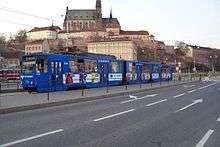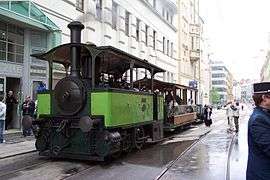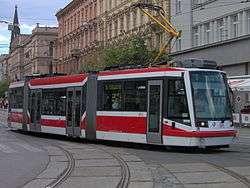Trams in Brno
 Tatra KT8D5 | |||
| Operation | |||
|---|---|---|---|
| Locale | Brno, Czech Republic | ||
| Open |
1869 (horse tram)[1] 1884 (steam tram)[1] 1900 (electric tram)[1] | ||
| Status | Operational | ||
| Routes | 13[2] | ||
| Operator(s) | Dopravní podnik města Brna | ||
| Infrastructure | |||
| Electrification | 600 V DC | ||
| Stock | 322 tram vehicles[2] | ||
| Statistics | |||
| Track length (single) | 139 km (86 mi)[2] | ||
| Route length | 70.4 km (43.7 mi)[2] | ||
| Passengers (2012) | 196.513 million (2013)[2] | ||
| |||
| Website | DPMB — How to travel | ||



The Brno tramway network (Czech: Tramvajová doprava v Brně, simple Tramvaje v Brně) was the first network of its kind to be put into operation in the nowadays Czech Republic, its horse tram lines dating back to 1869.[1] Today, Brno is the second largest city after Prague in the Czech Republic and its tram network is also the second largest in the country.
Currently, the Brno tram system comprises 13 lines,[2] with a total operational track length of 139 kilometres (86 mi)[2] and a total route length of 70.4 kilometres (43.7 mi).[2] The lines not only service the urban area, but also lead to the neighboring city of Modřice located south of Brno. Before construction began on the final leg of the extension in 2008, the entire network was made up of 69.7 km of track. The trams are operated by the City of Brno, Dopravní podnik města Brna (DPMB).
In the Brno dialect of the Czech language, the word for tram is ‘šalina’. The origins of this word can be traced to the German expression ‘Elektrische Linie’ (electric lines).
History
The first horse tram
Brno was the third largest city of the former Austro-Hungarian Empire and is today part of the Czech Republic. It was the first to install a horse-drawn tram service, which began on August 17, 1869.[1] Its route ran to Lažanskýplatz (now called Moravské náměstí, or Moravian Square) in the north of the city center, which was still at the time an independent municipality known as Královo Pole. Its operator was the 'Brno Tramway Society' for passenger and cargo transportation. Initially there were only six cars available and gradually the company bought a total of 57 passenger carriages.[1] There was an interruption in horse-drawn tram service between 1875 and 1877.[1]
The second horse tram
The company known today as Brno Tramway was launched in June 1876, with its first route running from the main station (Hauptbahnhof/Hlavní nádraží) to Pisárky. A short while after that, a second route was launched. Both routes were operated only during the summer months.
The steam tram
Steam trams began operation in the system in 1884, under the name Steam Tramway Brno. In the 1900s, the conversion from steam to electrical power began, but steam locomotives were still used, until 1914, to transport goods.[1]
The beginning of the electric tram
The first of the electric rail lines in Brno were put into operation on 21 June 1900.[1] These new lines included 41 railcars and 41 trailers; the latter acquired as many as 12 vehicles from the existing steam trains. These electric lines were operated by the Company Brno. While many other areas transitioned to electric, Brno's steam-powered trams were very efficient and it was more cost-effective to keep the technology unchanged. Cities with less established tram systems were considerably faster in terms of moving to electric power, including Prague and a number of other smaller towns such as Teplice, Liberec, and Olomouc.
Within the first year of operation several new lines were constructed, and soon a total of five lines were offered as part of the system. In 1914, Company Brno began to experience financial difficulties and was taken over by the Austrian electricity delivery group Aktiengesellschaft from Vienna. During World War I further expansion was considered, resulting in the extension of one line to a hospital.
Prime of the Brno tram
After the formation of Czechoslovakia in 1918, the Společnost brněnských elektrických pouličních drah (Society of Brno trams) was established. The Society's first task was to renovate the cars and tracks that had dilapidated during the war. Beginning in 1924 new lines were built, and a few years later the Society of Brno Trams began to focus on the construction of a second track for far-lane routes.
By 1938, a total of eight routes were in operation. In 1942, the Lokalbahn Brünn-Lösch/Brno-Líšeň, a classic train, was transferred and transformed into a train capable of traveling by a streetcar track.
Rolling stock
As of 2013, the Brno tramway network's fleet was:
| Image | Tram Car Type | Modifications and subtypes | In service |
|---|---|---|---|
 |
Tatra T3 |
Tatra T3G, Tatra T3R, Tatra T3T, Tatra T3P, Tatra T3RF, Tatra T3R.EV, Tatra T3R.PV | 127 |
 |
Tatra K2 |
Tatra K2, Tatra K2YU, Tatra K2R, Tatra K2R.03, Tatra K2R.03-P, Tatra K2P, Tatra K2T | 88 |
 |
Tatra KT8D5 |
Tatra KT8D5R.N2 | 38 |
 |
Tatra T6A5 | Tatra T6A5 | 20 |
 |
Škoda 03 T | Škoda 03T | 17 |
 |
Škoda 13 T | Škoda 13T | 29[3] |
 |
Vario LF | VarioLFR.E | 7 |
 |
Vario LF2 | VarioLF2R.E | 6 |
 |
VV60LF | VV60LF | 4 |
.jpg) |
Tatra RT6N1 | Tatra RT6N1 | 2 |
See also
References
Notes
Bibliography
- Bauer, Gerhard (1995). Strassenbahnen in der Tschechischen und Slowakischen Republik: von der Pferdebahn zum Tatrawagen; die Geschichte der tschechischen und slowakischen Strassenbahnbetriebe von einst und jetzt in Wort und Bild [Trams in the Czech and Slovak Republic: from Horsecars to Tatras; the history of the Czech and Slovak tram operators then and now in words and pictures] (in German). Dresden: Verlag für Verkehrsliteratur Bauer. ISBN 3980430308.
External links
![]() Media related to Trams in Brno at Wikimedia Commons
Media related to Trams in Brno at Wikimedia Commons
- Dopravní podnik města Brna, A.S. - Official Site (Czech) & (English)